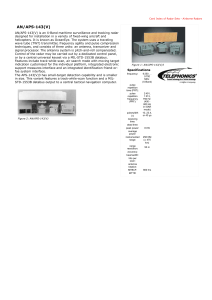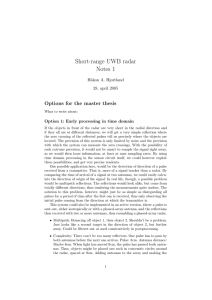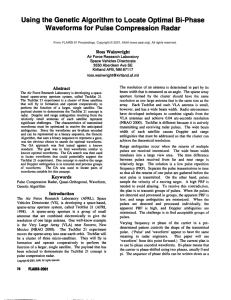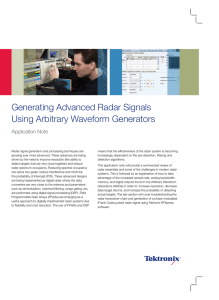MASSACHUSETTS INSTITUTE OF TECHNOLOGY Department of Electrical Engineering and Computer Science Issued:
advertisement
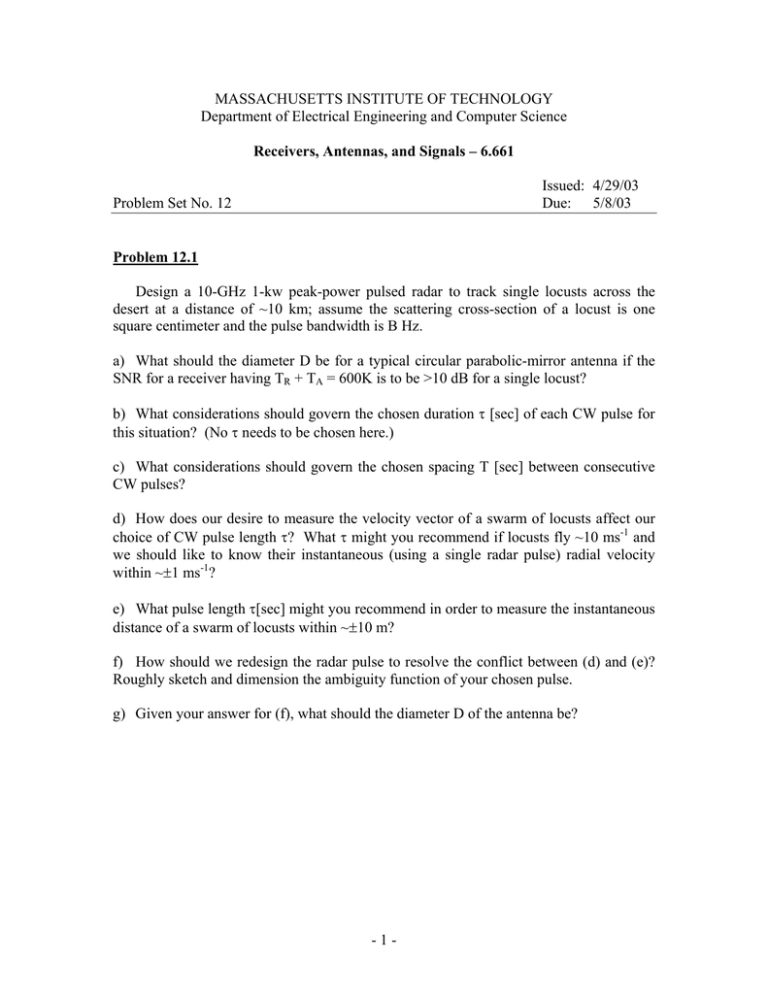
MASSACHUSETTS INSTITUTE OF TECHNOLOGY Department of Electrical Engineering and Computer Science Receivers, Antennas, and Signals – 6.661 Issued: 4/29/03 Due: 5/8/03 Problem Set No. 12 Problem 12.1 Design a 10-GHz 1-kw peak-power pulsed radar to track single locusts across the desert at a distance of ~10 km; assume the scattering cross-section of a locust is one square centimeter and the pulse bandwidth is B Hz. a) What should the diameter D be for a typical circular parabolic-mirror antenna if the SNR for a receiver having TR + TA = 600K is to be >10 dB for a single locust? b) What considerations should govern the chosen duration τ [sec] of each CW pulse for this situation? (No τ needs to be chosen here.) c) What considerations should govern the chosen spacing T [sec] between consecutive CW pulses? d) How does our desire to measure the velocity vector of a swarm of locusts affect our choice of CW pulse length τ? What τ might you recommend if locusts fly ~10 ms-1 and we should like to know their instantaneous (using a single radar pulse) radial velocity within ~±1 ms-1? e) What pulse length τ[sec] might you recommend in order to measure the instantaneous distance of a swarm of locusts within ~±10 m? f) How should we redesign the radar pulse to resolve the conflict between (d) and (e)? Roughly sketch and dimension the ambiguity function of your chosen pulse. g) Given your answer for (f), what should the diameter D of the antenna be? -1- Problem 12.2 A certain inverse synthetic aperture radar (ISAR) system consists of a single motionless 10-meter radar dish that views zenith at 10-cm wavelength. It images commercial jetliners flying directly overhead at ~10-km altitude. a) What is the approximate lateral (not range) resolution L(m) of this radar in normal (not ISAR) mode at 10-km altitude? b) What sort of pulse would yield 1-m range resolution? c) What is the approximate lateral resolution (m) of this radar along the flight path of a jetliner when operated in its ISAR mode? What is the resolution in the orthogonal direction? d) What changes to the radar operation are required to obtain 1-m resolution along the flight path? Please provide quantitative answers and assume D remains 10 meters. e) Assume the jetliners always fly between 8 and 12 km altitude. What is the maximum usable pulse repetition frequency (RPF)? f) If we use the techniques of part (d) to obtain ~10-cm resolution in range and 1-m resolution in the flight-path direction, is delay compensation necessary for the pulse envelope? If so, how much delay is required in the worse case? g) This ability to track the aircraft permits 10 images to be obtained with the original 10m resolution. What is the ratio of rms intensity fluctuations to mean intensity for each pixel of the reconstructed average image? Problem 12.3 A uniformly illuminated aperture antenna is 10-m square and operates at 1-cm wavelength. a) At what angle off axis is its first null? b) This antenna maps the sky, after which the high spatial frequencies of the resulting image are boosted to yield the principal solution. If the target consists of a spatial impulse (unresolved source), the restored image exhibits nulls at certain angles. At what angle off axis is the first null? c) Aperture synthesis is achieved by making multiple observations using two small antennas within the same 10-m square. At what angle off axis is the first null of the synthesized image? - 2 -
